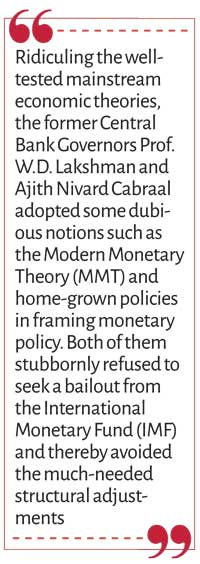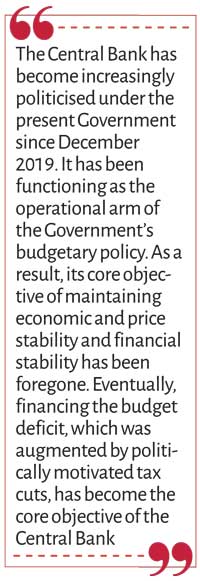Friday Jan 09, 2026
Friday Jan 09, 2026
Tuesday, 19 April 2022 00:17 - - {{hitsCtrl.values.hits}}

 Deviating from the low interest rate policy stance adopted over the last two years, the Central Bank at its monetary policy review meeting held on 8 April 2022 announced a doubling of the policy interest rates. Accordingly, the Standing Deposit Facility Rate (SDFR) and the Standing Lending Facility Rate (SLFR) of the Central Bank were raised by 700 basis points to 13.50% and 14.50%, respectively.
Deviating from the low interest rate policy stance adopted over the last two years, the Central Bank at its monetary policy review meeting held on 8 April 2022 announced a doubling of the policy interest rates. Accordingly, the Standing Deposit Facility Rate (SDFR) and the Standing Lending Facility Rate (SLFR) of the Central Bank were raised by 700 basis points to 13.50% and 14.50%, respectively.
Even before this policy announcement, market interest rates were on the rise due to heavy Government borrowings. Hence, the Central Bank is now compelled to give up the rigid low interest rate policy stance.
Soon after the interest rate hike, on the advice of the Central Bank, the Government announced that debt servicing of all foreign debts outstanding as of 12 April 2022, will be suspended for an interim period pending a restructuring program with assistance from the IMF. This ends Sri Lanka’s unblemished record of debt repayments maintained since Independence. This unilateral decision is tantamount to a hard debt default and therefore, it would be extremely difficult to mobilise foreign borrowings in months to come.
 Fixing the brakes impossible
Fixing the brakes impossible
While announcing the policy interest rate hike, the newly appointed Central Bank Governor, Dr. Nandalal Weerasinghe mentioned that his immediate objective is to fix the brakes and stop the economy, which is moving down, from crashing. Although this message is appreciative, it needs to be emphasised here that the current economic downfall cannot be stopped merely by raising interest rates as the whopping fiscal imbalance is bound to deactivate those brakes.
Continuous borrowing by the Government from the Central Bank and commercial banks has led to rapid money supply growth and galloping inflation and it is the root cause of the current economic crisis.
As in the past, however, the latest monetary policy review does not make any reference to the adverse implications of extensive Government borrowing. Thus, the Central Bank authorities are still reluctant to resist funding the fiscal shortfalls through the banking system due to political pressures.
Having been subservient to political masters in such a manner, the status of the Central Bank has diminished to the status of a timid follower of market movements, instead of being an independent monetary authority navigating the economy towards stability and growth.
The social unrest which is now spreading throughout the country, reflects how such bad economic management could wreck an entire nation.
Mainstream economics ridiculed
Ridiculing the well-tested mainstream economic theories, the former Central Bank Governors Prof. W.D. Lakshman and Ajith Nivard Cabraal adopted some dubious notions such as the Modern Monetary Theory (MMT) and home-grown policies in framing monetary policy. Both of them stubbornly refused to seek a bailout from the International Monetary Fund (IMF) and thereby avoided the much-needed structural adjustments.
Meanwhile, the former Treasury Secretary S.R. Attygalle took no action to contain the huge budget deficit or to reduce Government borrowing from the banking sector. Going beyond his mandatory duties, the former Presidential Secretary Dr. P.B. Jayasundera acted as the de facto architect of the Government’s economic policy. He asserted that Sri Lanka’s debt problem is a dramatised story and I debunked his argument in previous columns (https://www.ft.lk/columns/Is-Sri-Lanka-s-debt-problem-a-dramatised-story/4-715864).
Those ex-bureaucrats, apart from the political authorities, are responsible for the current economic mess.
The generous tax cuts implemented immediately after the Presidential election in November 2019 caused a revenue loss of around Rs. 600 billion per year resulting in a rise in the budget deficit to over 15% of GDP by now. The policy stance preferred by the Government and the Central Bank has been to maintain a low taxation regime and to meet the resulting budget deficit and debt obligations by printing money. This is exactly the policy mix suggested by the MMT promoters. 
As foreign borrowing became scarce, the Government had to heavily depend on domestic sources, mainly Treasury bills, to compensate for the mammoth revenue shortfall. As the yield rates of T’bills kept low, the weekly auctions were heavily undersubscribed, and therefore, the Central Bank had to buy the unsold stock of bills week after week. This caused a rise in the Bank’s net domestic assets and a consequent rise in currency (notes and coins) issues. The Central Bank’s net credit to the Government rose by a whopping 150% over the last 12 months. This together with commercial bank lending resulted in a rise in the money supply by 11% over this period.
Although the proponents of MMT including Lakshman and Cabraal argued that money supply growth does not cause inflation, the year-on-year inflation is now over 20%, as I predicted in this column in February last year (https://www.ft.lk/columns/Inflationary-pressures-on-the-horizon/4-712891).
Impossible trinity proved
Based on the home-grown policy myths, the Central Bank made failed attempts to fix both the exchange rate and interest rates at unrealistically low levels. Interest rate caps were imposed on bank deposits. The exchange rate was fixed initially at Rs. 180 per US dollar, and later it was raised to around Rs. 200 per dollar due to market pressures. Black market exchange rates were much higher. In the meantime, the Central Bank imposed low interest rate caps on bank deposits.
Such fixed exchange and interest rate system led to capital outflows proving the “impossible trinity” or “policy trilemma”, as I reiterated in this column previously (https://www.ft.lk/columns/Policy-trilemma-poses-formidable-challenges-to-interest-and-exchange-rate-management%20/4-713226). This theorem states that a central bank cannot simultaneously exercise monetary control and target the exchange rate along with free capital movement. A central bank can choose only two out of those three options.
As the Central Bank fixed both the exchange rate and interest rates simultaneously, foreign exchange inflows were discouraged and outflows were encouraged. This led to a depletion of foreign reserves to the bare minimum levels. As a result, the country now fails to meet even its essential import payments and debt service obligations.
 Is interest rate shock too harsh?
Is interest rate shock too harsh?
Having maintained a low interest rate policy stance for a long time, the Central Bank had to double the policy interest rates more recently due to heavy pressures of Government borrowing requirements. This was reflected in the substantial under-subscription at consecutive Treasury bill auctions despite the sharp increase in yield rates. The rise in interest rates is inevitable at this juncture given the exorbitant money supply growth that has led to accelerated inflation to double-digit levels by now.
The monetary policy review states that a substantial policy response is imperative to arrest the buildup of added demand-driven inflationary pressures in the economy and preempt the escalation of adverse inflationary expectations, to provide the required impetus to stabilise the exchange rate and also to correct anomalies observed in the market interest rate structure.
However, the steep rise in market interest rates following the policy rate hike is likely to be an unbearable shock to the ailing economy which is already battered by rupee depreciation, high inflation, fuel crisis, power cuts, food shortages, low international reserves, and foreign debt default.
Such a severe interest rate shock could have been avoided had the Central Bank followed a flexible interest rate policy allowing the market forces to determine the rates depending on demand and supply conditions.
Implications of rising interest rates
The cost of Government borrowing has already risen following the interest rate hike. This is reflected in the rise of the yield rate of 364-day Treasury bills to 15.69% at last week’s auction from 12.28% at the previous auction. As the Government is compelled to increasingly resort to domestic borrowings in the coming months given the limited potential to borrow from abroad due to the declaration of foreign debt default, there will be further demand pressures on the domestic debt market. This will result in a further increase in interest rates overburdening the Government coffers.
In the meantime, the rising interest rates will lead to escalating production costs stimulating cost-push inflation. This will have a negative impact on GDP growth which is already hit by multiple factors including high inflation, social and political instability, power cuts, energy crisis, raw material shortages, etc. The rising production costs will also have detrimental effects on the already weakened export competitiveness.
Debt default
The shortage of foreign exchange has become so severe that on the advice of the Central Bank, the Government suspended servicing of all external debts last week. Thus, the country is virtually declared bankrupt.
Sovereign debt default can put a country into a strenuous situation in the short term. But it is not uncommon for countries, particularly those in Latin America and Africa, to default on their debt. Some of those countries were able to overcome the crisis through effective debt restructuring programs with the help of the IMF.
A debt default adversely affects the concerned country’s international reputation. Depreciation of the currency is inevitable following a default. In the case of Sri Lanka, the rupee depreciated by 60% during the last 12 months before the suspension of debt servicing. Further depreciation following the debt default will accelerate inflation and worsen the living standards of the people.
Debt defaults also entail other cascading effects such as credit rating downgrades, higher interest rates on foreign loans, trade credit restrictions, and limited access to foreign borrowing. Bank insolvency and stock market crashes too are common outcomes of debt defaults.
Talks with IMF too late?
Having declared the debt service suspension, the authorities are about to start negotiations with the IMF at its spring meetings in Washington on 18-24 April. These talks were delayed for a long time due to the dogged stubbornness of the Government and the Central Bank despite the clear signs of a balance of payments crisis and debt default.
A financial assistance agreement with the IMF much earlier would have rectified the country’s macroeconomic misalignments and averted the chaos that the country is facing today. It would also have raised foreign investor confidence, inducing capital inflows.
In general, the IMF assists countries hit by crises by providing them financial support to create breathing room as they implement adjustment policies to restore economic stability and growth.
A country’s commitments to undertake certain policy actions, known as policy conditionality, are an integral part of IMF lending. The policy program underlying an arrangement is presented to the Fund’s Executive Board in a “Letter of Intent” and further detailed in a “Memorandum of Understanding”.
The IMF in its Article IV consultation report for Sri Lanka issued last month, emphasises the need for an ambitious fiscal consolidation that is based on high-quality revenue measures. A tighter monetary policy stance is recommended to contain rising inflationary pressures while phasing out the Central Bank’s direct financing of budget deficits. The IMF also recommends a gradual return to a market-determined and flexible exchange rate system to facilitate external adjustment and rebuild foreign reserves.
The political instability that Sri Lanka is facing today is going to be a major obstacle to having a successful arrangement with the IMF incorporating the above recommendations. It takes at least 4-6 months for a country to reach such an agreement under normal circumstances. In the case of Sri Lanka, the process will take a much longer period, given the current turmoil. The Government is yet to restore social and political stability. The lack of a credible economic program in its hand makes it more difficult for the Government to negotiate with the IMF effectively.
The announcement of the suspension of debt service payments before reaching an agreement with the IMF makes the situation even worse, as it is rather impossible to implement a debt restructuring program in the absence of IMF financing.
Depoliticisation of the Central Bank essential
The Central Bank has become increasingly politicised under the present Government since December 2019. It has been functioning as the operational arm of the Government’s budgetary policy. As a result, its core objective of maintaining economic and price stability and financial stability has been foregone. Eventually, financing the budget deficit, which was augmented by politically motivated tax cuts, has become the core objective of the Central Bank.
Ignoring the basic principles of economics, the Central Bank lavishly facilitated bank lending to the Government causing an unprecedented increase in currency issues and money supply. In order to minimise the Government’s borrowing costs, the policy interest rates were lowered to minimum levels and the exchange rate was fixed at an unrealistic rate. The fixed exchange and interest rate system has resulted in foreign exchange outflows, low foreign reserves, high inflation, fuel shortages, long queues, and ultimately countrywide protests against the Government.
The present Monetary Law Act provides sufficient space for the Central Bank to act as an independent body within the broad economic policy framework of the Government. It is the utmost responsibility of the Monetary Board headed by the Governor to exercise such independence to restore economic and price stability soon and thereby prevent further downfall of the economy.
(The writer, a former Central Banker, is Emeritus Professor of Economics at the Open University of Sri Lanka can be reached at [email protected].)